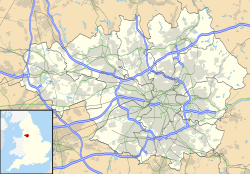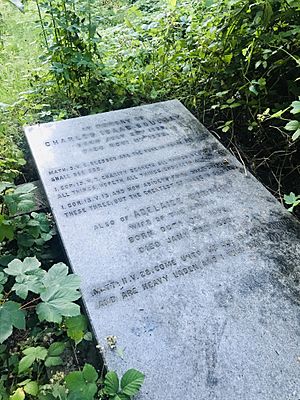St Paul's Church, Withington facts for kids
Quick facts for kids St Paul's Withington |
|
|---|---|

The church in September 2021
|
|
| 53°25′57″N 2°13′41″W / 53.43254°N 2.22794°W | |
| Location | Manchester, North-West England |
| Country | England |
| Denomination | Church of England |
| History | |
| Founded | 1841 |
| Architecture | |
| Heritage designation | Grade II listed |
| Designated | 1988 |
| Architect(s) | Hayley & Brown |
| Style | Neo-Norman |
| Specifications | |
| Materials | Red brick |
| Administration | |
| Parish | Withington |
| Deanery | Withington |
| Archdeaconry | Manchester |
| Diocese | Manchester |
| Province | York |
St Paul's Church, Withington is a historic church in Withington, a part of Manchester, England. It is a Church of England parish church, meaning it serves the local community. The church is located on Wilmslow Road and has a primary school next to it.
People come to St Paul's for traditional church services. These include Holy Communion, which is a special service. Sometimes, there are also evening prayer services.
Contents
History of St Paul's Church
St Paul's Church was built in 1841. At that time, Withington was changing from a small village into a busy part of Manchester. Before St Paul's was built, people in Withington had to travel to Didsbury to go to church.
A kind person named Wilbraham Egerton, 1st Earl Egerton gave the land for the church. He wanted to make sure local people had a place to worship. The church was designed by Hayley & Brown, an architecture company from Manchester. They also designed other churches in the North-West of England.
The School Next Door
Soon after the church was finished, a school was built right next to it in 1844. This was St Paul's Primary School. Lord Egerton also donated the land for the school. This shows how important the church and school were to the community.
A Famous Visitor: Felix Mendelssohn
In April 1847, a very famous composer named Felix Mendelssohn visited Manchester. He came to St Paul's Church to play the new pipe organ. A church leader from 1896 said that Mendelssohn "played a service and gave a recital upon the organ." Mendelssohn thought the organ was "an excellent instrument."
Mendelssohn had family connections to Withington. His wife's cousin had the first wedding ever held at St Paul's. Another cousin was married there in 1864.
Church Design and Features
St Paul's Church is built from red brick with stone details. Its most noticeable part is a tall clock tower. This tower has square supports called buttresses and four pointed tops called pinnacles.
The outside of the church has a style called Neo-Norman architecture. This means it looks like old Norman buildings. You can see this in the tall, rounded windows and the main entrance. The arch above the main door has cool carvings that look like "dog-teeth."
Inside the Church
The church was made bigger in 1863 by an architect named J. Lowe. He added a chancel, which is the area around the altar. He also added a side aisle and a room for the organ. These new parts were supported by rounded arches, like those found in Romanesque buildings.
In 1921, the chancel aisle was turned into a special chapel. This chapel remembers the soldiers who died in World War I. A small rounded section, called an apse, was added to the end of this chapel. The inside of the church was updated in the 1970s. However, it still has some of its original features from the Victorian era.
Stained Glass Windows
The church has beautiful stained glass windows. The three windows at the east end were made by Ward and Hughes. In the main part of the church, there are two windows from 1901 by a local artist, Walter J. Pearce. One shows a young Queen Victoria. The other is a stained-glass copy of a famous painting called Light of the World by Holman Hunt.
In the war memorial chapel, there are four small windows. These windows honor the people from the church's Sunday school who died in World War I.
Memorials and Churchyard
You can find several memorials on the walls inside the church. The oldest one remembers Robert Tebbut, who helped build St Paul's. He died in 1842, just one year after the church was founded. The memorial says he was a main reason the church was built.
The churchyard has many old Victorian gravestones. In 1894, a strong oak gate, called a lych gate, was put at the entrance. A local helper named Clayton Chorlton donated it. Sadly, in 2007, these gates were stolen during a Sunday morning service.
Images for kids
-
Dog-tooth ornamentation above the Neo-Norman west door






